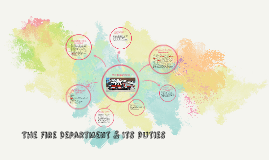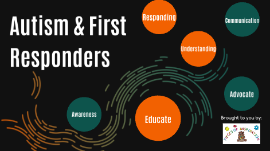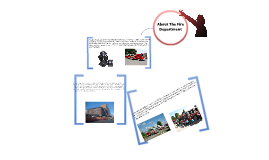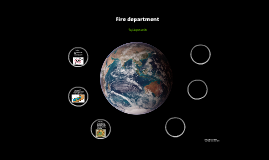Fire Department
Transcript: Autism & First Responders Brought to you by: Awareness Awareness What is Autism? Autism Spectrum Disorder (ASD) is a developmental disability that typically appears during the first two years of a child's life and is the result of a neurological disorder that affects: Brain functioning Communication skills Social interaction ASD presents as a combination of characteristics that vary in degree of severity. Characteristics often affect social skills, motor planning, ability to communicate verbally, and can also include unusual behavior patterns. ASD varies in each individual's strengths and weaknesses, everyone is unique! What is Autism? The CDC found that 1 in 68 children has a diagnosis of autism as of 2014. This number has been on the rise for decades and continues to rise. Although there is not a scientifically proven cause for Autism, the rise in prevalence is most likely due to increasing awareness and improved ability to diagnose ASD. What is Autism? Autism is a spectrum or an “umbrella” condition. This means that, while all people with autism share certain difficulties, their condition will affect them in different ways. Autism is a Spectrum Autism Aspergers Childhood Disintegrative Disorder Pervasive Development Disorder Not Otherwise Specified (PDD-NOS) The “umbrella” term indicates a range of severities and a range of impairments. Some individuals may have “mild” deficits, while others will have “severe” deficits. There is no “set” definition of a person with autism. Impairments can include: Delay or lack of language The child may be non-verbal or may be language delayed. Difficulty with joint attention A child with autism may turn away from you or refuse to make eye contact. This is not a sign of disrespect. Social cognition The child may be unable to answer simple, social questions. Autism is a Spectrum "If You've Met One Person with Autism, You've Met One Person with Autism." -Steven Shore Educate Why is being aware of autism important for first responders? Individuals with autism are 7 times more likely to come in contact with first responders than their neuro-typical peers. 91% of deaths are caused by drowning As the growing number of children with autism become adults, a broader understanding of the disorder will be critical to safe and successful interactions. Why is being aware of autism important for first responders? THERE ARE SEVERAL FACTS THAT ARE ESPECIALLY IMPORTANT TO THINK ABOUT AS LAW ENFORCEMENT… Some commonplace situations or objects may be obviously dangerous to us. However, individuals with autism may not see these as “red flags.” A Different Perspective Dangers they may not understand include: Risks associated with deep water, strangers, traffic, railroad crossings, heights, tripping hazards, broken glass, poisons, chemicals, pharmaceuticals, edged weapons, firearms and fire hazards. Autism affects how a person communicates with and relates to other people. It also affects how they make sense of theworld around them. A Different Perspective They have an alternate sense of fear. They learn differently than us. This can cause their personal interpretation of their surroundings to be different from ours. As a first repsonder, situations you are more prone to encounter with individuals with Autism Spectrum Disorder include: Wandering/Elopement Drowning Disturbance Calls Potential Risks Wandering/Elopement is the tendency for an individual to try to leave the safety of a responsible person’s care or a safe area, which can result in potential harm or injury. This might include running off from adults at school or in the community, leaving the classroom without permission, or leaving the house when the family is not looking. Children with autism have challenges with social and communication skills and safety awareness. This makes wandering a potentially dangerous behavior. Wandering & Elopement Individuals with Autism can often seem to display behaviors that can be interpretted as suspicious to the untrained eye: flapping, pacing, making unusual noises, and abrupt movements This can be seen as threatening or frightening to neighbors or others in public places that are unfamilair with the individual Disturbance Calls You may be called to a situation where there is an indivdual that may need to be calmed & needs assist contacting a parent/caregiver Approach the situation calmly rather than in defense mode, while always remaining cautious Disturbance Calls Because of their impaired ability to communicate and socially interact, they may be more likely to be victims of institutional abuse. Abuse may take place in: Group homes Treatment facilities Schools Hospitals Nursing homes Residential facilities Vulnerability Due to Lack of Communication Individuals with Autism are often attracted to water When combined with a lack of safety awareness, individuals with ASD seeking water can become very dangerous and even lethal When recieving a call of a missing individual with Autism, it is important

















